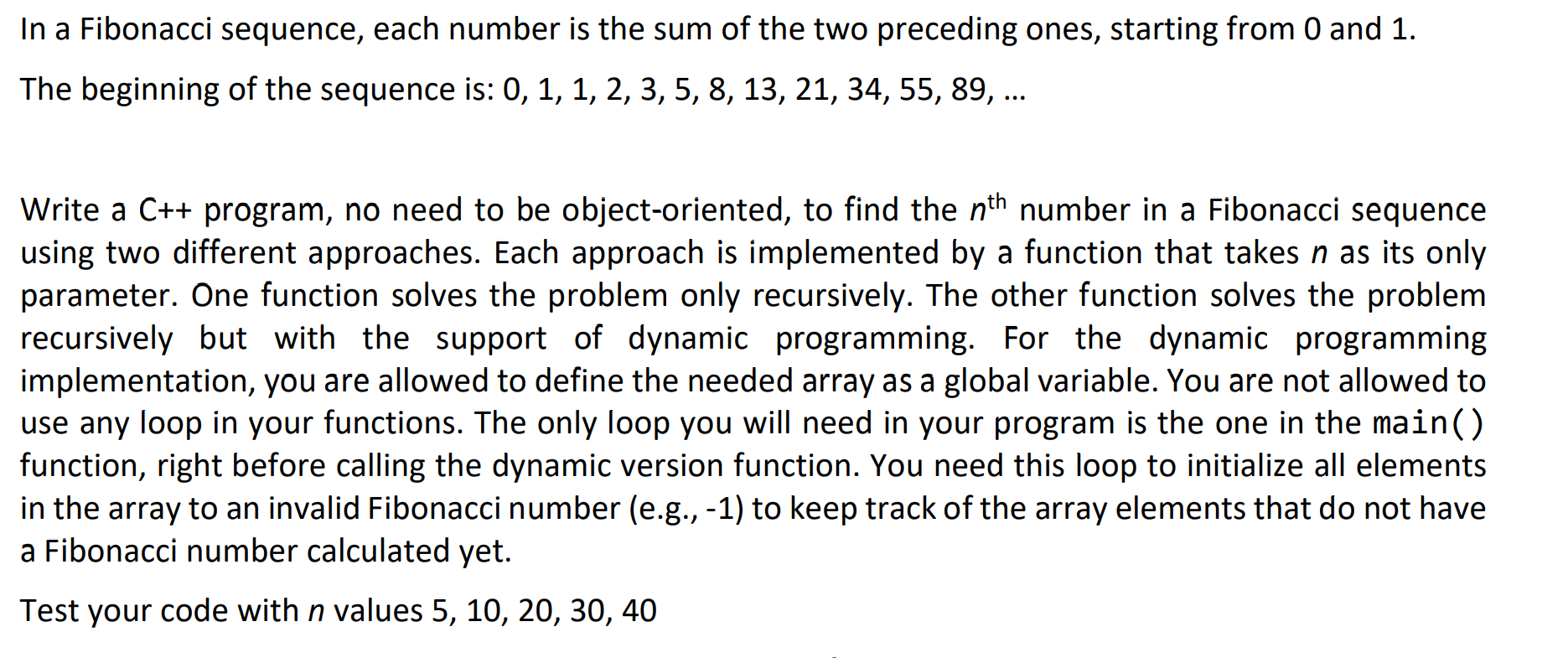In a Fibonacci sequence, each number is the sum of the two preceding ones, starting from 0 and 1. The beginning of the sequence is: 0, 1, 1, 2, 3, 5, 8, 13, 21, 34, 55, 89, ... Write a C++ program, no need to be object-oriented, to find the nth number in a Fibonacci sequence using two different approaches. Each approach is implemented by a function that takes n as its only parameter. One function solves the problem only recursively. The other function solves the problem recursively but with the support of dynamic programming. For the dynamic programming implementation, you are allowed to define the needed array as a global variable. You are not allowed to use any loop in your functions. The only loop you will need in your program is the one in the main() function, right before calling the dynamic version function. You need this loop to initialize all elements in the array to an invalid Fibonacci number (e.g., -1) to keep track of the array elements that do not have a Fibonacci number calculated yet. Test your code with n values 5, 10, 20, 30, 40
In a Fibonacci sequence, each number is the sum of the two preceding ones, starting from 0 and 1. The beginning of the sequence is: 0, 1, 1, 2, 3, 5, 8, 13, 21, 34, 55, 89, ... Write a C++ program, no need to be object-oriented, to find the nth number in a Fibonacci sequence using two different approaches. Each approach is implemented by a function that takes n as its only parameter. One function solves the problem only recursively. The other function solves the problem recursively but with the support of dynamic programming. For the dynamic programming implementation, you are allowed to define the needed array as a global variable. You are not allowed to use any loop in your functions. The only loop you will need in your program is the one in the main() function, right before calling the dynamic version function. You need this loop to initialize all elements in the array to an invalid Fibonacci number (e.g., -1) to keep track of the array elements that do not have a Fibonacci number calculated yet. Test your code with n values 5, 10, 20, 30, 40
Database System Concepts
7th Edition
ISBN:9780078022159
Author:Abraham Silberschatz Professor, Henry F. Korth, S. Sudarshan
Publisher:Abraham Silberschatz Professor, Henry F. Korth, S. Sudarshan
Chapter1: Introduction
Section: Chapter Questions
Problem 1PE
Related questions
Question
Please help me withe the second function with the dynamic

Transcribed Image Text:In a Fibonacci sequence, each number is the sum of the two preceding ones, starting from 0 and 1.
The beginning of the sequence is: 0, 1, 1, 2, 3, 5, 8, 13, 21, 34, 55, 89, ...
Write a C++ program, no need to be object-oriented, to find the nth number in a Fibonacci sequence
using two different approaches. Each approach is implemented by a function that takes n as its only
parameter. One function solves the problem only recursively. The other function solves the problem
recursively but with the support of dynamic programming. For the dynamic programming
implementation, you are allowed to define the needed array as a global variable. You are not allowed to
use any loop in your functions. The only loop you will need in your program is the one in the main()
function, right before calling the dynamic version function. You need this loop to initialize all elements
in the array to an invalid Fibonacci number (e.g., -1) to keep track of the array elements that do not have
a Fibonacci number calculated yet.
Test your code with n values 5, 10, 20, 30, 40
Expert Solution
This question has been solved!
Explore an expertly crafted, step-by-step solution for a thorough understanding of key concepts.
This is a popular solution!
Trending now
This is a popular solution!
Step by step
Solved in 3 steps with 3 images

Knowledge Booster
Learn more about
Need a deep-dive on the concept behind this application? Look no further. Learn more about this topic, computer-science and related others by exploring similar questions and additional content below.Recommended textbooks for you

Database System Concepts
Computer Science
ISBN:
9780078022159
Author:
Abraham Silberschatz Professor, Henry F. Korth, S. Sudarshan
Publisher:
McGraw-Hill Education

Starting Out with Python (4th Edition)
Computer Science
ISBN:
9780134444321
Author:
Tony Gaddis
Publisher:
PEARSON

Digital Fundamentals (11th Edition)
Computer Science
ISBN:
9780132737968
Author:
Thomas L. Floyd
Publisher:
PEARSON

Database System Concepts
Computer Science
ISBN:
9780078022159
Author:
Abraham Silberschatz Professor, Henry F. Korth, S. Sudarshan
Publisher:
McGraw-Hill Education

Starting Out with Python (4th Edition)
Computer Science
ISBN:
9780134444321
Author:
Tony Gaddis
Publisher:
PEARSON

Digital Fundamentals (11th Edition)
Computer Science
ISBN:
9780132737968
Author:
Thomas L. Floyd
Publisher:
PEARSON

C How to Program (8th Edition)
Computer Science
ISBN:
9780133976892
Author:
Paul J. Deitel, Harvey Deitel
Publisher:
PEARSON

Database Systems: Design, Implementation, & Manag…
Computer Science
ISBN:
9781337627900
Author:
Carlos Coronel, Steven Morris
Publisher:
Cengage Learning

Programmable Logic Controllers
Computer Science
ISBN:
9780073373843
Author:
Frank D. Petruzella
Publisher:
McGraw-Hill Education